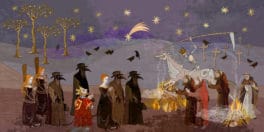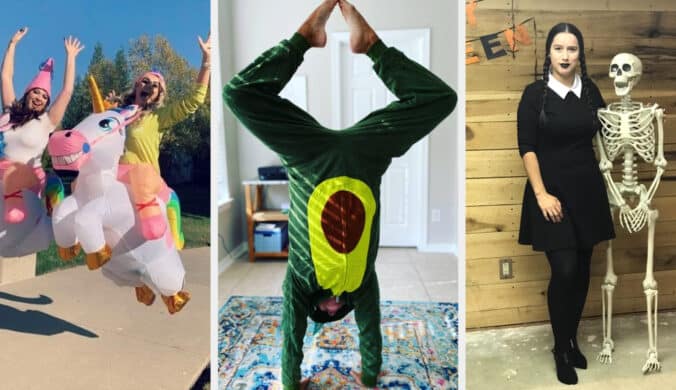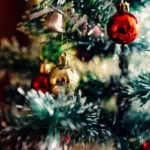Halloween on October 31 is undoubtedly the creepiest, most ghostly holiday of them all. Children dress up as Batman, the Joker, Wonder Woman, or some other favorite character; go to parties or walk their neighborhoods with jack o’ lanterns full of sweets as they go trick-or-treating. Spooky decorations fill windows and porches and screams can be heard in living rooms up and down the country as we collectively binge our favorite horror movies.
Though Halloween is expected to look somewhat different this year, See’s Candies wanted to let everyone know that you can still celebrate and have fun, safely! There are many ways to celebrate Halloween that don’t involve going door-to-door trick-or-treating in search of Halloween sweets.
History of Halloween
The word, Halloween or Hallowe’en dates from before the 16th century and draws from its early Christian past. In old Scottish, Hallowe’en translates as “All Hallows’ (holy) Even” referring to “All Hallows’ Evening,” the day before All Hallows Day, a solemn occasion in which all of the Catholic Church’s heavenly saints were honored. By the 18th century, Halloween shows up with the spelling we know today.
Halloween History

Going back in time, Halloween is fascinating because it has lots of practices that date back to its pagan origins. For example, the Halloween tradition of bobbing for apples reminds us of the Roman invasion of England. As part of Roman paganism, they brought an apple tree, symbolic of Pomona, Goddess of Plenty. During an annual festival, young marriage-minded people bit into apples floating in the water. According to beliefs, whoever bit the apple was next to marry.
But it’s really the Celts we have to thank for Halloween. They were ancient people who lived in the areas of modern-day Ireland, northern France, and in the UK. Halloween’s pagan roots go back thousands of years to the Celtic Fire Festival of Samhain, which recognized the end of the harvest season and the start of their new year on November 1.
During this festival, pagans wore costumes and lit fires to keep the bad spirits away – keep that in mind when you’re donning your Dracula fangs! With the dark nights of winter representing death, the Celts believed that on October 31, the dead returned to walk among the living. Sounds kind of zombie-ish, right?
The Christian Influence

As Christian influence on society began to grow around the 8th century, new customs and traditions were brought in and merged with those of the Celts. Christians would celebrate All Souls Day on November 2, which was a day to honor the dead in much the same way that the Celts did on Samhain. It was around this time that the evening before the celebration became known as All Hallows Eve.
After All Hallows Day was officially switched to November 1 in 835, October 31 became known as All Hallows Eve and the holiday we know and love today was starting to take shape. By the 12th century, these days had gained holy importance throughout Europe, and customs such as ringing the church bells for the souls of those in purgatory had become widespread.
A typical Halloween would see a mournful crier parading through the streets, dressed all in black, ringing bells, and encouraging the locals to pray for the souls of the dead. It was around this time that “souling” began to happen, but there’s more about that further down in the trick-or-treat section. By the Middle Ages churches were too poor to display the relics of martyred saints and so churchgoers began dressing up as them every year instead. This could partly explain where the tradition of dressing up on Halloween stems from.
Halloween in America
Halloween became popular in America in the 19th century, with enthusiasm for the holiday being brought across with the Irish and Scottish immigrants who were arriving at the time. The biggest change from Halloween’s earliest roots is that it becomes more secular than religious. By the 1920s and 30s, Halloween parades and parties became a major part of the festivities and the holiday was celebrated from coast to coast, regardless of race or religious background.
Trick-or-Treating

Trick-or-treating is said to stem from the practice of “souling”, which is a Medieval practice where churchgoers would go between different parishes and ask the rich for pastries which were known as soul cakes. In return, they would pray for the souls of them and their friends. While “souling”, people would carry with them lanterns made of hollowed-out turnips. That turnip is now of course a pumpkin and it is believed that that the jack-o-lantern originally represented the souls of the dead.
By the late 19th century children in Scotland and Ireland were dressing up in costume and going from door to door accepting gifts from neighbors, this practice was known as “guising”. The children would generally be given bits of food for their efforts. The first recorded instance of this in America is in 1911. The term trick-or-treat was first used in Alberta, Canada, in 1927, and by the 1930s it was starting to become a popular activity.
Modern Day Halloween
By the 1950s Halloween became a holiday that was primarily for the children. Trick-or-treating was commonplace as kids went around their neighborhoods in costume collecting candy. Halloween became increasingly embedded in popular culture and horror movies would often be released to coincide with the holiday. Movies such as “Nightmare on Elm Street,” “Halloween,” and “Friday the 13th” have all become classics associated with the holiday.
Halloween is now America’s second-largest commercial holiday, with $6 billion being spent on it each year. Numerous traditions such as trick-or-treating, costume parties, and watching horror movies all contribute towards a huge occasion that is celebrated throughout the country.
Halloween plays off our phobias. Killer clowns and antique dolls creep you out? Bats and spiders make your skin crawl? Does the sight of blood make you faint? Don’t go into that room and don’t go out on Halloween. But if you do — look over your shoulder! On Halloween, be a kid again or take on a new persona. Watch out for ghosts and goblins and things that go, “bump” in the night. Eat as much candy as your tummy can hold. Enjoy feeling totally scared for just. one. night. Happy Halloween, everybody!
Halloween timeline
As Christianity continued to merge with Celtic traditions, historians believe that All Souls Day was an effort by the early church to sanction a holiday that honors the dead without totally doing away with the Celtic New Year on November 1.
In Scotland and Ireland, young people would go door to door in their communities, reciting poetry, singing, telling jokes or even doing tricks to get free food and gifts as part of the day to honor the dead.
The infamous Salem Witch trials' officials falsely accused, then tortured and killed 19 girls, women and men.
Halloween de-emphasizes ghosts and goblins and replaces them with community gatherings, games, food and fun when newspaper editors and community leaders ask parents to refrain from celebrating anything scary for Halloween.
Although the custom of going from door to door asking for treats dates back to the Middle Ages, American youngsters put a new spin on it with "Trick or Treat."
Halloween By Numbers
172 million – Americans celebrating Halloween each year
69% – of people who plan to hand out candy
$8.8 billion – total Halloween spend in 2019
$86.27 – amount spent on decorations, candy, and costume by the average consumer
48% – of people wear a costume on Halloween
46% – of people carve a pumpkin
16% – of people dress up their pets
36 million – trick or treaters each year
Halloween Activities
Hand out candy
If you're too old for trick or treating, it's time to return the favor! Don a wig and a mask (but not too scary!) and with groans, howling and chains rattling from your audio setup, hand out lots of candy. Create some serious Halloween fun for the kiddies!
Visit a haunted house
Lose control for a little while in a haunted house. Find out who jumps the most — but no matter how crazy the scene, remember, it's all just make-believe fun! (Or, IS it?)
Enjoy campy fun listening to the original "War of the Worlds"
On October 30, 1938, Orson Welles and his Mercury Theatre on the Air program broadcast a chilling version of H.G. Wells' classic, "War of the Worlds." So many people believed the broadcast was genuine, that there was massive panic all over the country. Invite some folks over, pop some corn, eat some candy and go back in time to listen to one of the great voices play on your emotions right before Halloween!
5 Halloween Facts We're Dropping Into Your Trick Or Treat Bag
"Soul cakes" go way back
The practice of giving “soul cakes” goes back to England in the Middle Ages when the poor or “soulers” went door to door receiving small, round cakes or “souls” during All Hallow’s Eve on October 31 as a way to remember the dead. Giving and receiving soul cakes continues today in other countries including Portugal and Ireland.
Illinois, the pumpkin capital — who knew?
15,000 acres yields over 500 million pumpkin pounds, according to the U.S Department of Agriculture.
Candy corn was literally called, "chicken feed" — seriously?
Candy corn, which looks remarkably as it did in the 1880s when it came on the market, was originally sold as "chicken feed" with rooster images on the boxes as a way to target an agricultural market, according to the "National Geographic."
Look closely at the Michael Meyer's mask in "Halloween."
Have you ever noticed that in the classic film, “Halloween,” the Michael Meyers’ mask looks remarkably similar to William Shatner? Before widening the eyes and painting it white, the iconic look came from a “Captain Kirk” mask the “Halloween” movie producers found in a Hollywood magic shop in 1978.
During WWII, no sugar — no "trick or treat"
With sugar rationing part of the war effort, Halloween was put on "pause" until after WWII. Then, candy companies boosted their advertising after the war, turning Halloween into the next major holiday after Christmas.
Why We Love Halloween
Release your inner ghoul
Halloween gives us a reason to see a different side of ourselves. Whether you go for goofy, or opt for spooky, this ghoulish holiday is the day to don a costume and go wild!
It's an excuse to party
Is there a better day of the year for groups of all ages and cultures to party into the night? Halloween seems to know no boundaries. Whether children bob for apples or adults play "Pin the Tail on the Whatever," Halloween parties are absolutely the best!
It's a night of nostalgia for adults
For many people across the world, Halloween brings back a lot of memories. We get to be kids again but some of us can play out our fantasies. Bottom line, Halloween is a fun night filled with colors, candy and costumes.
Halloween dates
| Year | Date | Day |
|---|---|---|
| 2025 | October 31 | Friday |
| 2026 | October 31 | Saturday |
| 2027 | October 31 | Sunday |
| 2028 | October 31 | Tuesday |
| 2029 | October 31 | Wednesday |

























